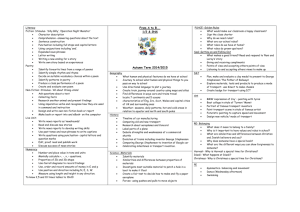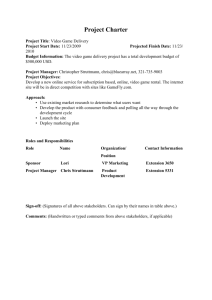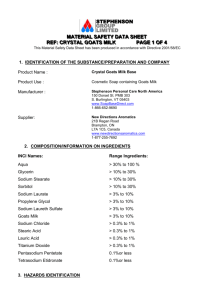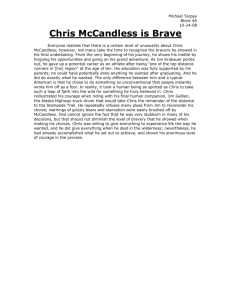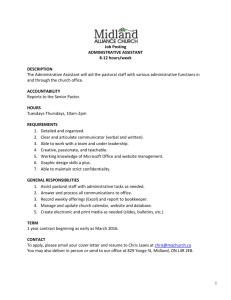Topics in Computer Science
advertisement
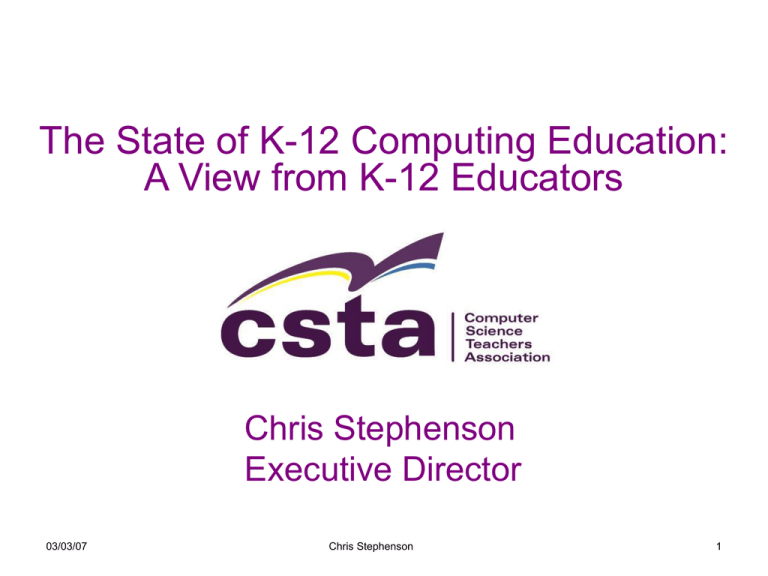
The State of K-12 Computing Education: A View from K-12 Educators Chris Stephenson Executive Director 03/03/07 Chris Stephenson 1 This material is based upon work supported by the National Science Foundation under Grant No. 0455403. Any opinions, findings, and conclusions or recommendations expressed in this material are those of the author(s) and do not necessarily reflect the views of the National Science Foundation. 03/03/07 Chris Stephenson 2 Agenda • Computing as a discipline in K-12 • What the research says • Issues that affect us • Key principles • The need for change • The view from the front 03/03/07 Chris Stephenson 3 Computing as a Discipline • Definition difficulties: – Computing is a new area within a very old educational cannon – Computing as a field is evolving so quickly that it is difficult even for computer scientists to define its contents and delimit its boundaries – Deciding what students need to know in this field is like trying to hit a moving target • What we know for sure: – Computing science is a scientific discipline and not just a technology that supports learning in other areas – There are recurring concepts and principles that students need to know (abstraction, complexity, modularity, and reusability) – Computing is a discipline with a core set of scientific principles that can be applied to solve complex real-world problems and promote higher-order thinking • Many people within education (and in funding bodies) do not understand the difference between having computers in schools and teaching computing as an academic discipline 03/03/07 Chris Stephenson 4 What the Research Tells Us • Only 26% of schools require students to take a computer science course • Only 40% of schools even offer AP CS • 76% of school teach some kind of introductory computing course but the course contents are inconsistent and usually lack rigor • Lack of time in the students’ schedules is the greatest impediment to students taking computing courses • 89% of high school computer science teachers say they experience a sense of isolation and a lack of collegial support in their schools and in their districts • Noting the rapid changes in technology and in teaching, teachers indicated that their greatest professional development need was actually finding time for their own on-going learning 03/03/07 Chris Stephenson 5 Why We’re in Trouble • Computing teachers feel isolated within their schools and districts • Most administrators do not understand that computing is a scientific discipline just like physics and biology • There is no consistency in computing curriculum requirements from stateto-state, district-to-district, or even in some cases, school-to-school • There is no consistency in teacher certification requirements • Computing teachers do not receive the professional development they need to keep their teaching and technical skills current • There is a disconnect between K-12 CS educators and their college and university colleagues • Administrators, legislators, and congressional committees do not understand the link between supporting K-12 computing education and economic/workplace issues (the national discourse example) 03/03/07 Chris Stephenson 6 Why Enrollment Is Dropping • Students and their parents do not understand the incredible scope of educational and career opportunities that computing provides • Students want to be part of a discipline that is solving real problems, and they do not understand that computing is at the root of all of the new sciences • Students’ schedules are so jammed packed that they do not have time to take elective courses • The emphasis on standardized testing in core areas is pulling emphasis, funding, and good teachers away from computing 03/03/07 Chris Stephenson 7 The Truth About AP • The College Board determines the content of the AP exam based upon surveys of universities and colleges • When demand, applications, and enrollments were high, the APCS exam served as a convenient gate keeper • While other AP exams represent exemplary high school courses, the AP CS exam is equivalent to a second year data structures course • While other disciplines are able to scaffold knowledge and skills with multiple courses throughout K-12, the AP CS course is often the only CS course students can take 03/03/07 Chris Stephenson 8 The Impact of NCLB • This year, the No Child Left Behind legislation was implemented in high schools • Under this legislation, federal funding is withdrawn from schools where students fail to reach specified performance levels on standardized tests in math and reading • The result: – Non-core courses are being cancelled – Funds are being withdrawn from other programs – Computing teachers are being pulled out of their classrooms to teach remedial mathematics 03/03/07 Chris Stephenson 9 The Teacher Certification Mess • CSTA research indicates that: – Certification requirements vary enormously from state to state – Many states require computer science teachers to hold multiple certifications with CS as a secondary to some other discipline – Some states require CS teachers to take and pass praxis exams in other disciplines (math, business, vocational technology) – Teachers are ill-informed as to the requirements in their own state – Many DOE people responsible for certification are ill-informed as to the requirements in their own state (primarily because they do not know what computing is) – In some states where there are clearly-stated requirements, there is no way for them to be met (the Florida example) 03/03/07 Chris Stephenson 10 How Do We Change Things? • Change is a long-term process, not a short term intervention • Curriculum must have both bottom up and top-down support • Successful curriculum implementation requires buy-in at every level (federal policy makers, state policy makers, school district administrators, principals, teachers, colleges and universities, schools of education, business and industry) • Major change agents must be in place at all levels • Adequate resources must be made available throughout all of the stages of curriculum design and implementation (funding for resources, hardware and software, learning materials, professional development) 03/03/07 Chris Stephenson 11 What If We Don’t Change? • Our students will fail to receive the education they require to compete in an increasingly technological global economy • Businesses and industries will continue to be unable to find the people with the skills they need for the jobs that exist now and in future • Our economic power as a nation depends upon our ability to build the tools the rest of the world needs and while computer science education languishes in the U.S., other countries are driving toward the future by providing computer science education for their students • The computing sciences are driving innovation in every single field of science and we will continue to lose the innovation edge 03/03/07 Chris Stephenson 12 Seven Systemic Changes to Improve Teaching • • • • • • • Mastery of Knowledge: New high school computing teachers should be required to have completed an undergraduate degree in computer science or a comparable degree program Standardized Pre-service Programs: All teacher preparation programs should be required to adhere to the National Council for Accreditation of Teacher Education (NCATE) standards for high school computer science educators Certification standards: State teacher certification requirements for high school computing teachers should adhere to a consistent (and enforced) national standard that would allow for greater clarity and mobility from state to state. Professional Development: School districts should provide regular professional development for computing teachers to allow them to keep their knowledge and skills current Focus on Teaching: School districts should employ a sufficient number of technical specialists with responsibility to ensure that computer hardware, networks, and software is maintained, freeing teachers to concentrate on their teaching Competitive Compensation: Salaries for computing teachers should be commensurate with those offered in industry to ensure that the best possible candidates prepare and apply for teaching positions Professional Affiliation: All high school computing teachers should be members of professional associations that support their discipline-based knowledge and provide a teaching community that mentors and celebrates them 03/03/07 Chris Stephenson 13 Ten Principles of Curriculum Design • Focus on underlying scientific principles • Develop student familiarity with abstraction, complexity, modularity, reusability • Focus on problem solving and critical thinking • Help students develop a range of capabilities/skills independent of technologies • Give a broad overview of the field (history, computing in other disciplines) • Deal explicitly with design, maintenance, and analysis • Enable students to scaffold new ideas, concepts, and skills across a series of courses with age-appropriate outcomes • Use teaching strategies that make the content engaging to all students • Interweave conceptual and experimental issues • Don’t confuse computer science with computer literacy or computers across the curriculum 03/03/07 Chris Stephenson 14 Five Implementation Requirements • Support: – The initiative must have top-down and grassroots support and agents must be in place at all levels to ensure continued enthusiasm and support • Stakeholder buy-in: – External groups must have a role in the review process (teachers unions, professional associations, parent councils, universities/colleges, business/industry) • Resources: – Schools, teachers, and students must be provided with the resources they need for successful implementation (hardware, software, textbooks, reference materials, manipulatives) • Professional development: – Teachers must receive training to allow them to master the curriculum content and effective teaching strategies • Timeframe: – Every step takes time and real system change takes up to ten years. Giving less time than truly needed to accomplish any step along the implementation path from vision to reality can condemn the entire process to failure 03/03/07 Chris Stephenson 15 Five Qualities of Exemplary Teachers • Problem-solving Approach: Exemplary computer science teachers use a problemsolving approach that allows students to examine problems from different angles and perspectives and formulate solutions • Real World Focus: Exemplary computer science teachers motivate students by having them create real-world artifacts with an intended audience and encouraging them to understand the essential link between the problem, the user, and the solution • Explicit Emphasis on Design: Exemplary computer science teachers explicitly teach and use the software design process, ensuring that students master the steps involved in designing, creating, testing, and debugging software • A Welcoming Environment: Exemplary computer science teachers make their classroom a welcoming environment for all students (especially young women and minority students) and find creative ways to engage all students with examples and exercises that are relevant to their lives. • Modeling Life-long Learning: Exemplary computer science teachers serve as role models for their students by continuing to enhance their own teaching and technology skills and by exploring new ideas and new technologies 03/03/07 Chris Stephenson 16 The View from the Front Administrators concerned about growth are always in the midst of the fray, in the process of change with both feet. While our new role…places leaders at the top and bottom of the hierarchy, administrators of the future who can tolerate the ambiguity of the role will spark change that can only happen in institutions where everyone is growing. And we will no longer be ignoring the very people who can make a school great, or not—the teachers. M. Poplin, Educational Leadership, 49(5), 1992. 03/03/07 Chris Stephenson 17 Panelists • Jerome Esparza – Computer Magnet Instructor; Thomas Jefferson High School • Daniel Gohl – Principal; McKinley Technology High School • Michelle Hutton: – Computer Science Teacher; The Girls Middle School • Kevin Marlatt – Computer Magnet Director; Denver Public Schools 03/03/07 Chris Stephenson 18 Question 1 • What do you see as the most pressing need right now in terms for improving K-12 computing education? What needs to change right now? 03/03/07 Chris Stephenson 19 Question 2 • What do you see as the greatest impediment to improving K-12 computing education? What is getting in your way? 03/03/07 Chris Stephenson 20 Question 3 • Who do you see as the primary stakeholders in the struggle to improve computing education in K-12? Who is already on the bus and who needs to get onboard? 03/03/07 Chris Stephenson 21 Question 4 • How would you describe the relationship between K12 and colleges and universities? Are we relatively in tuned or are we two solitudes? 03/03/07 Chris Stephenson 22 Question 5 • How can organizations and individuals from the corporations and non-profit sector help us improve computing education in K-12 ? 03/03/07 Chris Stephenson 23 Question 6 • How can we work more effectively together to support change and improve student learning? 03/03/07 Chris Stephenson 24 Contact Information Chris Stephenson Executive Director, CSTA Phone: 1-800-401-1799 Fax: 1-541-687-1840 cstephenson@csta.acm.org 03/03/07 Chris Stephenson 25

